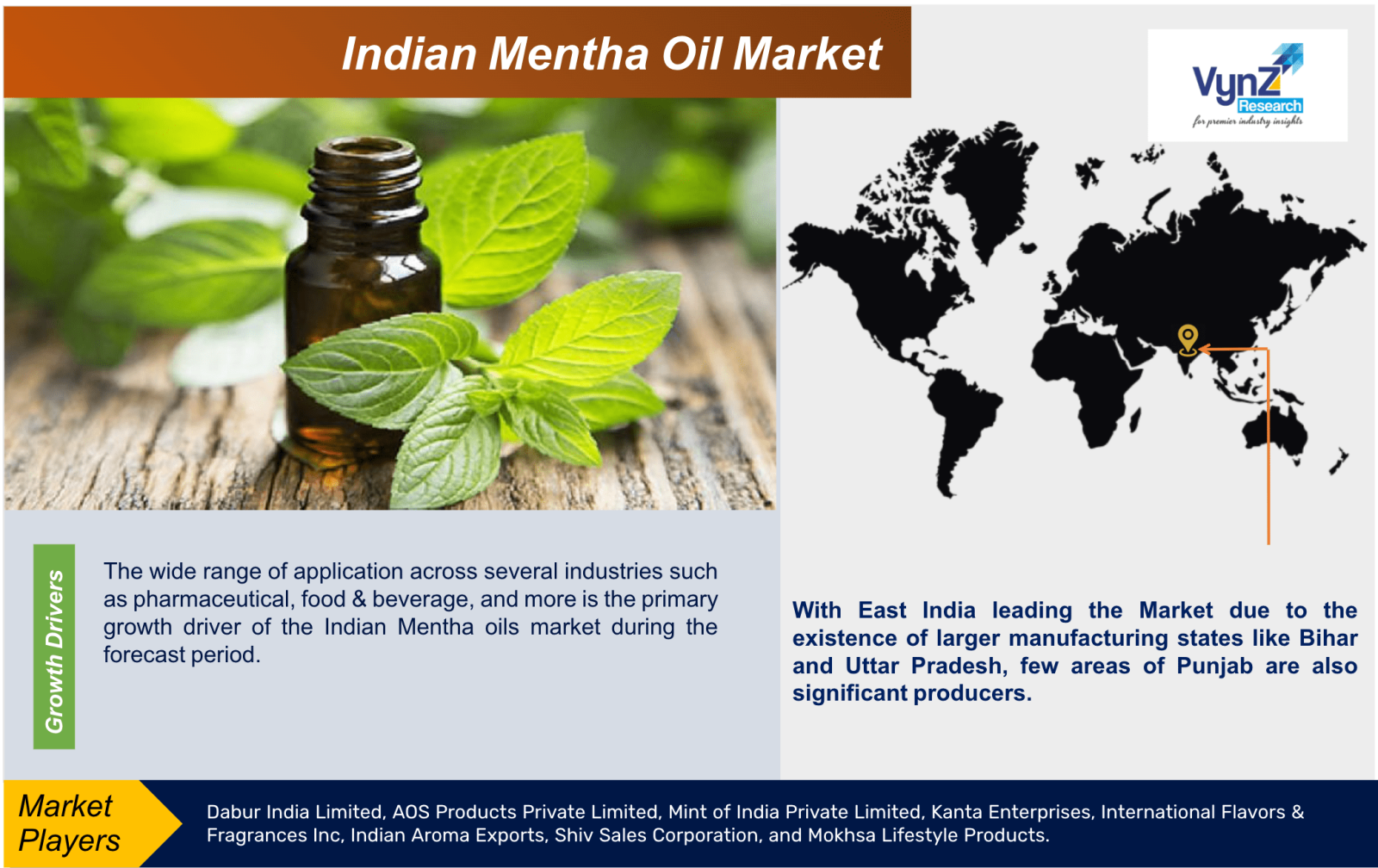Industry Overview
The Indian Mentha oil market size was valued at approximately 11.7 Thousand Metric Tonnes in 2023 which is expected to grow at a consistent CAGR of around 4.10% during the forecast period to reach nearly 15.9 thousand Metric Tonnes by 2030.

Mentha oil, extracted from Mentha Arvensis herb, is a major export of India, primarily produced in Uttar Pradesh, Bihar, and Punjab. About 60% of the annual production is exported worldwide, with the remainder consumed domestically by FMCG, pharma, and tobacco industries. It finds applications in food, beverages, personal care, aromatherapy, and as a commodity for trading on exchanges like NCDEX and MCX.
The market is diverse in types, applications, and extraction methods, with peppermint oil dominating, Dementholized Oil showing promise, and cosmetics segment growing. Steam distillation is prevalent, while SFE holds potential.
Uttar Pradesh and Bihar lead production, with Madhya Pradesh showing growth potential. Quality grading favors HMO, with MMO promising. Bulk buyers dominate domestically, while the export market shows high potential for expansion.
Market Segmentation
Insight by Type
Within the Indian Mentha oil market, the products are categorized into two primary groups namely, singles and blends thereby dividing the market into these two segments.
Out of these two segments, the singles segment, comprising oils derived from a single Mentha species, holds a dominant position in the market due to the distinct flavor and aroma profiles. However, the blend variety, which combines oils from multiple Mentha species, is also gaining a strong foothold into the market, especially in applications where a balanced or customized flavor profile is necessary.
Insight by Product
The Indian Mentha oil market can be broadly divided into peppermint oil, spearmint oil, corn mint oil, menthol oil, Dementholized Oil (DMO), and terpene less oil segments based on the product.
Out of these segments, the peppermint segment has a larger share due to the high demand. It is mainly attributed to its powerful fragrance and wide applicability across a wide range of industry verticals which includes food & beverage, personal care, and medicines. It is also attributed to its high menthol content and versatile applications in several industries.
However, the Dementholized Oil (DMO) also shows promise for significant growth in the forecast period due to rising demand for natural fragrances and flavors and lower menthol content, especially useful in the food and cosmetics industries.
Insight by Application
The Indian Mentha oil market is segmented into aromatherapy, personal care & cosmetics, food & beverages, pharmaceuticals, tobacco, perfumery, and other industrial uses. Aromatherapy is projected to lead due to lifestyle changes and increased demand for therapeutic products. Pharmaceuticals dominate with Mentha oil used in medicinal products. Food & beverages will grow significantly, driven by antimicrobial properties enhancing shelf life. Rising disposable income and awareness will boost sales in cosmetics and personal care products containing Mentha oil. Overall, diverse applications and increasing demand propel the Indian Mentha oil market's growth.
Insight by Distribution Channel
The Indian Mentha oil market is further segmented based on distribution channels into direct and retail segments. Out of the two, the direct segment, categorized by direct sales channels such as business-to-business (B2B) transactions and agreements with bulk buyers, holds a dominating position in the market. This is attributed to established relationships between Mentha oil producers and large-scale consumers across various industries.
However, the retail segment, comprising channels like specialty stores, online platforms, and supermarkets, is poised for substantial growth in the forecast period. Increasing consumer demand for natural and herbal products, coupled with the rising availability of Mentha oil-based products in retail outlets, is expected to drive the expansion of the retail segment at a significantly high rate. This trend echoes evolving consumer preferences and the growing market infiltration of Mentha oil products outside conventional industrial applications.
Insight by Extraction Methods
Based on the extraction methods the Indian Mentha oil market is divided into Steam Distillation, Solvent Extraction, Cold Press Extraction, and Supercritical Fluid Extraction (SFE) segments.
While the steam distillation segment is the dominating extraction method due to the extensive use across different industries, the Supercritical Fluid Extraction (SFE) segment is expected to grow at a significant rate during the forecast period due to its eco-friendly nature, higher efficiency in extracting specific compounds, and increasing adoption in the pharmaceutical and food industries.
Insight by Quality Grading
The Indian Mentha oil market can be divided by different quality grading based on menthol content, color, and odor, optical rotation, and specific gravity. Out of these sections, the menthol-based grading can be further divided into High Menthol Oil (HMO), Medium Menthol Oil (MMO), and Dementholized Oil (DMO) segments.
Consider all these segments, the High Menthol Oil (HMO) is the dominating grade due to its high demand in pharmaceuticals and oral care products but the Medium Menthol Oil (MMO) segment is also showing promise for significant growth in the forecast period. It is mainly attributed to its more balanced profile of menthol content and higher applicability in a wider range of products.
Insight by End Users
The type of end users also divided the Indian Mentha oil market into Bulk Buyers, Distributors and Traders, Small and Medium-Sized Enterprises (SMEs), and Export Market.
Out of these segments, the bulk buyer’s segment, comprising large-scale consumers, dominates the market due to the high purchasing power and extensive usage of Mentha oil. However, the export market segment is showing promise for significant growth in the analysis period fueled by increasing demand from international markets.
Indian Mentha Oil Market Report Coverage
|
Report Metric
|
Details
|
|
Historical Period
|
2018 - 2023
|
|
Base Year Considered
|
2024
|
|
Forecast Period
|
2025 - 2030
|
|
Market Size in 2024
|
U.S.D. 11.7 Billion
|
|
Revenue Forecast in 2030
|
U.S.D. 15.9 Billion
|
|
Growth Rate
|
4.10%
|
|
Segments Covered in the Report
|
By Type, By Product, By Application, By Distribution Channel, By Extraction Methods, By Quality Grading, and By End Users
|
|
Report Scope
|
Market Trends, Drivers, and Restraints; Revenue Estimation and Forecast; Segmentation Analysis; Impact of COVID-19; Companies’ Strategic Developments; Market Share Analysis of Key Players; Company Profiling
|
|
Regions Covered in the Report
|
North India, South India, and East India
|
Industry Dynamics
Industry Trends
The manufacturers are now focusing more on product innovations to cater to diverse consumer preferences and investing more on research and development for new formulations and applications for Mentha oil in food, beverages, and aromatherapy.
There is a growing emphasis on quality control measures and obtaining relevant certifications from the authorities to meet international standards and ensure the purity and authenticity of Mentha oil products.
The rapid technological advancements in extraction methods adopted enhances the efficiency, quality, and yield of Mentha oil extraction.
Efforts are made to diversify Mentha cultivation beyond traditional regions like Uttar Pradesh to states like Madhya Pradesh, Punjab, and Haryana, due to favorable government support and climatic conditions.
There is an increased focus on organic cultivation, eco-friendly extraction methods, and sustainable farming practices to reduce environmental impacts and meet the increasing demand for responsibly sourced Mentha oil.
Growth Drivers
The wide range of application across several industries such as pharmaceutical, food & beverage, and more is the primary growth driver of the Indian Mentha oils market during the forecast period.
The rise in demand for natural and organic products with longer shelf life among people is also facilitating the growth of the market.
The market growth is being propelled by the significant initiatives taken by the government to promote its use in making different medicines that will facilitate preventive healthcare. This is mainly attributed to the inherent healing properties in the oil extract.
The growing awareness about the health benefits among the consumers leading to higher adoption, extensive use in making confectionaries, and the popularity of traditional medicine systems such as aromatherapy and Ayurveda will also propel the growth of the Indian Mentha oil market.
The growing popularity of herbal and Ayurvedic products is also driving the demand for Mentha oil in formulations for medicines, cosmetics, personal care and wellness products.
Challenges
Growing imports, decline in production, non-lucrative prices, shifting preference to low-cost synthetic menthol of industrial buyers, the changing dynamics, lower capacity utilization, rising distress at growers’ level, higher cost of cultivation, lower ROI, and the drop in Mentha cultivation acreage, poses significant challenges to the growth of the Indian Mentha oil market.
Opportunities
The surge in Mentha oil prices by as much as 18% due to production decline and the initiatives of the government to boost production by segregating HSN codes and reviewing the current import policy, change in regulations regarding label disclosure and mandatory use of least percentage of the oil in products, rising public awareness of the benefits of the oil is creating new opportunities for growth.
Geographic Overview
The Indian Mentha oil market is also divided by the regions into North India, South India, and East India. With east India leading the market due to the existence of larger manufacturing states like Bihar and Uttar Pradesh, few areas of Punjab are also significant producers.
Ideally, Uttar Pradesh remains the dominating state in Mentha oil production due to a significant portion of India's total production. However, states like Madhya Pradesh is also showing significant growth and is expected to account for a significant portion of the Indian Mentha oil market due to increase in cultivation and government support for promoting Mentha cultivation in the states.
Competitive Insight
Dabur India Limited, AOS Products Private Limited, Mint of India Private Limited, Kanta Enterprises, International Flavors & Fragrances Inc, Indian Aroma Exports, Shiv Sales Corporation, and Mokhsa Lifestyle Products.
.png)
Source: VynZ Research
.png)
Source: VynZ Research




.png)
.png)